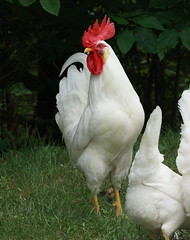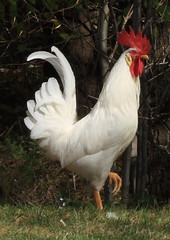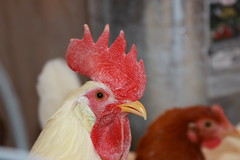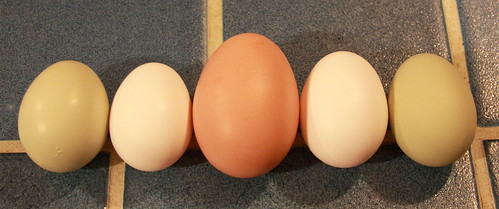Thursday, October 30, 2008
Production is Falling (with the leaves)
The @#$&%&#*! dogs were outside for a long time today (to keep them from bothering/eating the painter that is working in our dining room). They got bored and decided that instead of digging holes they would hunt chickens. They caught and killed one of the Pearl White Leghorn hens. Actually, she was not dead when I got them away from her, but she had died by the time I got the dogs in their crates in the house and got back out to put her out of her misery. I am so sick of the dogs.
I think we are now down to 11 hens and one rooster (Bill). This is down from a total of 75 last Fall. That is some serious attrition.
Monday, August 18, 2008
Update on the Summer's Happenings
The last of our New Hampshire Reds are no longer with us. The second to last disappeared without a trace. Something must have snagged her in the woods, because I didn't even see the telltale scattered feathers that usually accompanies an attack. The last one didn't lay an egg for three days. She was kinda moping around. Then she laid the biggest, fatest egg I have ever seen. After that, her laying-end did not look good and she died in the coop three days later. So, now we are not getting any more brown eggs.
This summer, the colored eggs have been popular. We have seen an increase in egg sales during the tourist season and have sold out of the araucana (blue) eggs a couple of times. We have not yet sold out of white eggs, but our backlog is only a few dozen.
Our sales have been pretty sporatic - we sometimes don't sell any eggs for 3-4 days, and then we sell eight dozen in one day. Weird.
I will be redoing my cost model soon - the reduced feed consumption during the summer (due to free-range foraging) has led to a significant deviation from my original model. During these summer months, we are showing an operating profit. However, we still probably are showing an overall loss due the the fact that I fed 75 chicks for several weeks just to have the majority of them wiped out by a weasel.
We are talking seriously about building a new coop. We want to address a couple of important deficiencies of the current coop that we inherited from the previous owner:
1. It sucks in so many ways. It leaks (the roof doesn't extend all the way to the exterior walls). It is not predator-proof. The door is too narrow to walk through while carrying a fifty pound bag of feed. The door opens in and extends low enough that every time you close it, you pull a bunch of chicken poop out the door. Very nasty "mud" when it rains.
2. It is at the top of a hill far from the house and barn. This is not bad in the summer, but in the winter it is too steep to snow-blow a path. And the path gets icy anyway. And it is a long way to carry water on a steep, icy path.
3. We want a dual-coop. We want to be able to run two flocks in the coop at once. Typically, the second half will have broilers (but will also have layers occasionally when we want to "reboot" our laying flock). The idea would be to have a wall across the middle of the coop with a door in it. The "wall" will probably just be chicken wire.
We will probably build a new coop right behind the barn. It will share a wall with the new sheep shed that I need to build. Supposedly, sheep and chickens are quite compatible. The sheep will be in this shed and adjoining pen during the winter months when there is no pasture for them to eat. I have a vague hope that with the sheep stomping down the snow in the pen, the chickens might be able to have an outdoor area where they can be free-range even in the winter. And maybe they can forage for some of their own food among the bugs attracted to the sheep, the sheep poo and the hay/bedding for the sheep.
Monday, May 19, 2008
Foraging for Profit
During the winter, a 50 pound bag of layer pellets was lasting about eight days. Lately, a bag has been lasting about 20 days. That is a huge cost savings, especially since the cost of feed has gone up so much. There has been no decrease in egg production or quality. However, the number of double-yolk eggs has decreased - I am not sure if this is due to the change in diet/exercise, or just a function of the hens getting older.
We have been selling eggs at $2.50 a dozen at the street and to friends. Business has been steady, and we expect demand to pick up some once tourist season hits.
Friday, April 18, 2008
Price Elasticity
Thursday, April 10, 2008
Path to Profitability?
Many of the local flocks are selling eggs for $2.00/dozen. Of course, some of them don't have very good eggs. To quote my lovely farm wife Catherine, "They have icky whites." At least she has not become an egg snob...
Based on my decades of experience in business I am thinking we need to reduce expenses and/or increase our sales price. Smart, huh?
We stopped by Clark's Grain Store and I chatted with The Guy about volume discounts, etc. It turns out that we want to stick with Blue Seal Layer feed, because it gives the best and most consistent nutrition. It turns out that volume discounts start at about three tons of loose (not bagged) feed. With our current flock, it would take us about two years to use that up. And I have no place to store it. For bagged feed, we can get about 10% discount if we buy at least one ton. That would take about 40 weeks to consume. I bought five bags and saved about 1%. Yay.
So we have raised the price for our eggs to $2.50/dozen. Our eggs are great quality (because we are feeding the good stuff), and they are distinctive because of the Araucana "rainbow" eggs. Time to do some marketing.
Friday, April 4, 2008
Predators Solved?
We have had no more problems with predators. All the girls are happy, healthy and laying like crazy. The one remaining rooster struts around the coop like big man on campus.
Everyone is anxious to get outside - each time I open the coop door, everyone starts to make a run for it. We still are buried under a few feet of snow, so I have been keeping everyone inside. We have had been having some warm weather the last week or so and have had some good meltage. Of course, it has been snowing all morning. Ugh.
We have been selling lots of eggs, mostly to friends and family. We have been charging $2 per dozen, which is what most of the small flocks charge around here. I have also been tracking expenses. Unfortunately, it looks like our expenses are more than $2 per dozen. We have some work to do on marketing/pricing. In addition, we need to see if we can get a better deal on feed (our primary expense).
Sunday, February 24, 2008
More Predator Problems
I got further confirmation of a problem when I tried to push open the door and it was blocked by a dead hen. A little more shoving and grunting and I got the door open enough to get in the coop. Although there were still chickens walking around and roosting, my eyes were drawn to the dead bodies strewn about the floor. The surviving chickens got an extensive lesson in four-letter words...I was a bit steamed.
I grabbed an empty feed bag from the bin outside the coop and started loading bodies into it. I also discovered why I had such a hard time getting into the coop: there was a body jammed behind the door that was blocking from opening all the way. The final count: nine hens dead. Each of the dead had a small wound on the neck and no other obvious injuries. Unlike previous attacks, there were no missing heads. The bodies filled the feed bag (50lb). And it felt like it weighed about 50 pounds.
We are now down to 18 hens and one rooster.
A little history
In September, we ordered 75 female-only chicks. One was DOA. One more died within the first 24 hours. A couple of months ago, we suffered four attacks. The first left two dead (missing heads). The next night, 12 were killed. At least half were missing heads and the rest had messy neck wounds. In response, I blocked the chicken-sized door much more securely (the door doesn't close, there is just a board that goes across it that is held in place with a large paver). Two uneventful weeks went by, and then there were an even dozen casualties. I re-secured the chicken-sized door, but the next night 15 were killed. Again, missing heads.
These attacks were clearly violent. The heat lamp(s) were knocked to the ground with broken bulbs. The ever-present dust was swept clean from most surfaces and there were wing marks in the dust on all the walls nearly to the ceiling.
At this point, I was ready to tear my hair out. I could not figure out how the perp was getting in. After searching high and low, I realized that the venting in the eaves of the coop (front and back) was open with no wire covering the holes. This left 2-3" wide holes 8-10 feet off the ground. My best guess was that something was either climbing the exterior wall or dropping to the roof from an overhanging limb, and slinking in through the eaves.
So, on a bitterly cold and windy day in November, I covered all these holes with chicken wire and crossed my (frozen) fingers. At this point, we were down to 32 chickens (31 hens and one rooster).
These measures appeared to do the trick.
A couple months later, Catherine and I decided to take a walk in the woods during a Nor'easter. It was a pretty intense storm, and I had made sure the chickens would be able to get through the day without a visit from me if I decided to stay in all day. But since I was out anyway, I went to check in on the girls. As I was walking across the yard, I noticed lots of steam coming out from under the eaves. It was blowing like crazy, bitterly cold and snowing really hard.
When I got to the door, I discovered that the "steam" was actually smoke. Acrid smoke. When I got the door open, I was struck by the fact that the smoke was so think I couldn't see the other side of the coop (ten feet away). I was also struck by the nasty burning plastic fumes.
One of the chickens apparently decided to roost on the lamp or the lamp's wire and knocked it to the ground. It landed face down and didn't break the bulb. The lamp landed in the plastic tray that sits under the waterer. It burned a hole in the plastic and started the wood and litter beneath it smoldering. It took about 20 minutes to get the fire out completely - I had to throw everything out into the snow. An hour later, I had the heat lamp nailed to the ceiling so it will not ever come down again, and all the wires are neatly tacked out of the way.
Once the smoke had cleared, I found that three of the hens were dead. I am surprised it wasn't worse! It took about three weeks before the smell from this incident was completely gone from the coop and my coat.
Flash forward to this week
So how did something get back in? Dunno. There is no sign that a beast forced its way under the wire that I tacked over the eaves, but I supplemented the defenses by nailing boards over the edge of the wire. Using a ladder in four feet of snow is lots of fun.
Is it possible that the perpetrator can fit through the holes in the chicken wire? Maybe I should have used hardware cloth? Drew blames the rooster - could this be an inside job?
We are discussing the possibility of a new coop - we would like to get it away from the edge of the woods and also be able to build in better defenses. We are also talking about how/when to replenish the flock.
Saturday, February 16, 2008
Getting Started
The previous owner had built a chicken coop and kept a flock of layers. On moving day, he offered to leave some chickens for us. Catherine said, "Sounds great, but not more than a dozen." The previous owner set us up with a 3-gallon waterer, a hanging feeder, a 50-pound bag of feed and about 10 minutes of instructions on how to keep the chickens alive. We were chicken farmers. Or is it egg farmers? I still don't know which we are.
The day after we moved in, we were eating the freshest, most delicious eggs we had ever had in our lives! What a treat!
Our 2007 flock consisted of nine hens and three roosters. The hens were a mixed bag: a couple of Barred Rocks and a bunch of scraggly Ameraucana. The roosters were an awesome Barred Rock and two fancy shmancy bantams. Each day, we got a handful of brown and blue-green eggs.
Our flock was free-range. Each morning, we let the flock out of the coop to wander the property (and sometimes across the street). They ate lots of bugs and pooped everywhere. Each evening, they would return to roost in the coop and we would close the door overnight to keep them safe. Our dogs quickly became obsessed with eating chicken poop and would search high and low for a tasty morsel in the yard.
This worked out pretty well, although we did have a couple of incidents. A couple of times the flock scattered with great fanfare as some sort of predator was sighted. When the coast was clear, the roosters would go to the coop and call the girls home. There were a few of these scares with no harm done, although on one occasion one of the hens was killed and gutted, probably by a coyote. On another occasion, one of the hens got a mauled wing - I found her being licked tenderly by one of our Aussies (Pumpkin Pie). When I found her, I thought she was dead; unfortunately I had to help her along. To make matters worse, I had to do it during a conference call for work - fortunately I was able to mute my cell phone...
Overall, things went smoothly through the spring and summer. However, our egg production (which was always questionable) began to have serious issues. Eventually, we were feeding ten birds and getting only a couple of eggs a day.
Important lesson: If someone is happy to give you a dozen chickens, don't be surprised if they are a bunch of old ladies that are nearly done laying.
It was at that point that we decided it was time to reboot the flock.



